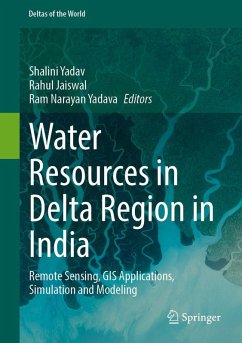
Geospatial Innovations in Disaster Management
An Overview of Recent Developments
Herausgegeben: van Westen, Cees J.; van den Homberg, Marc; Kerle, Norman; Nabukulu, Catherine
Versandkostenfrei!
Versandfertig in 6-10 Tagen
38,99 €
inkl. MwSt.

PAYBACK Punkte
19 °P sammeln!
As we confront increasingly frequent and complex disasters, geospatial information plays a central role in effective disaster management.This open access book offers a comprehensive examination of how spatial data, cutting-edge technologies, and innovative approaches are revolutionising the way we prepare for, respond to, and recover from disasters. From remote sensing and artificial intelligence to social media monitoring and geohealth applications, it demonstrates how geospatial innovations are reshaping every stage of the disaster management cycle. Clear explanations, real-world case studie...
As we confront increasingly frequent and complex disasters, geospatial information plays a central role in effective disaster management.
This open access book offers a comprehensive examination of how spatial data, cutting-edge technologies, and innovative approaches are revolutionising the way we prepare for, respond to, and recover from disasters. From remote sensing and artificial intelligence to social media monitoring and geohealth applications, it demonstrates how geospatial innovations are reshaping every stage of the disaster management cycle. Clear explanations, real-world case studies, and practical tools guide readers through concepts ranging from multi-hazard risk assessment to impact-based forecasting.
Designed for professionals, researchers, and students in disaster management, geography, and geoinformatics, this book bridges theory and practice. It not only highlights the potential of spatial technologies but also critically examines their limitations, ethical challenges, and future directions. By connecting data-driven methods with humanitarian needs, it equips readers with the knowledge to harness geospatial information for more resilient societies in the face of evolving hazards.
This open access book offers a comprehensive examination of how spatial data, cutting-edge technologies, and innovative approaches are revolutionising the way we prepare for, respond to, and recover from disasters. From remote sensing and artificial intelligence to social media monitoring and geohealth applications, it demonstrates how geospatial innovations are reshaping every stage of the disaster management cycle. Clear explanations, real-world case studies, and practical tools guide readers through concepts ranging from multi-hazard risk assessment to impact-based forecasting.
Designed for professionals, researchers, and students in disaster management, geography, and geoinformatics, this book bridges theory and practice. It not only highlights the potential of spatial technologies but also critically examines their limitations, ethical challenges, and future directions. By connecting data-driven methods with humanitarian needs, it equips readers with the knowledge to harness geospatial information for more resilient societies in the face of evolving hazards.












